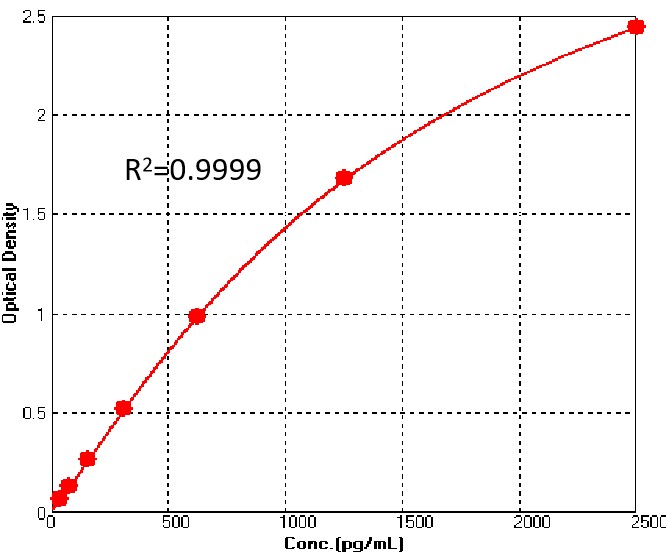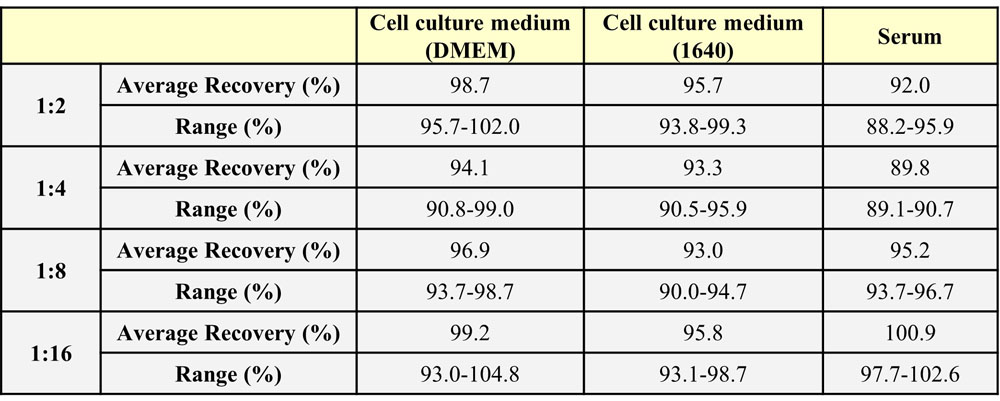产品参数(Product Specifications)
| Assay Type | Sandwich-ELISA |
| Analyte | IL-2 |
| Format | 96T(8×12 strips) |
| Reactivity | Human |
| Regulatory Status | RUO |
| Sensitivity | < 39.06 pg/mL |
| Standard Curve Range | 39.06 pg/mL-2500 pg/mL |
| Assay Time | 2 hr 50 min |
| Suitable Sample Type | For the quantitative determination of human IL-2 in Cell Culture Supernatants, Plasma, Serum. |
| Sample volume | 100 uL |
产品概述(Product Overview)
resDetect™ Human Interleukin-2 (IL-2) ELISA Kit (Residue Testing) is based on the ELISA sandwich method and is used to detect and quantitatively determine GMP human IL-2 in cell culture supernatants, serum, and plasma. The kit contains GMP human IL-2 (ACROBiosystems, cat#GMP-L02H14) to ensure accurate assay results and is designed to provide a reliable solution for CAR-T product quality assessment during drug development and CMC quality control stages. It can also be used as a universal detection tool for the quantitative determination of human IL-2.
重构方法(Reconstitution)
Please see Certificate of Analysis for details of reconstitution instruction and specific concentration.
存储(Storage)
1. Unopened kit should be stored at 2℃-8℃ upon receiving.
2. Find the expiration date on the outside packaging and do not use reagents past their expiration date.
3. The opened kit should be stored per components table. The shelf life is 30 days from the date of opening.
组分(Materials Provided)
| ID | Components | Size |
| CRS003-C01 | Pre-coated Anti-IL-2 Antibody Microplate | 1 plate(8×12 strips) |
| CRS003-C02 | Human IL-2 Standard | 20 μg |
| CRS003-C03 | Biotin-Anti-IL-2 Antibody | 50 μL |
| CRS003-C04 | Streptavidin-HRP | 50 μL |
| CRS003-C05 | 10xWashing Buffer | 50 mL |
| CRS003-C06 | 2xDilution Buffer | 50 mL |
| CRS003-C07 | Substrate Solution | 12 mL |
| CRS003-C08 | Stop Solution | 7 mL |
质量管理控制体系(QMS)
典型数据-Typical Data Please refer to DS document for the assay protocol.

For each experiment, a standard curve needs to be set for each micro-plate, and the specific OD value may vary depending on different laboratories, testers, or equipments. The following example data is for reference only.
验证(Validation)
稀释线性(Dilution Linearity)
To assess the linearity of the assay, samples spiked with high concentrations of human IL-2 were serially diluted with calibrator diluent to produce samples with values within the dynamic range of the assay.

批内差异(Intra-Assay Statistics)
Three samples of known concentration were tested twenty times on one plate to assess intra-assay precision, Intra-Assay Precision CV<10%.

批间差异(Inter-Assay Statistics)
Three samples of known concentration were tested in three separate assays to assess inter-assay precision, Inter-Assay Precision CV<10%.

回收率(Recovery)
Three parts of blank serum were added with different concentrations of human IL-2, and the serum without human IL-2 was used as background to calculate the recovery rate. The range of the recovery rate is 83.9-98.2%, and the average recovery is 90.2%.

 +添加评论
+添加评论背景(Background):IL-2
IL2,TCGF,lymphokine,Interleukin 2
Interleukin-2 (IL-2) is an interleukin, a type of cytokine immune system signaling molecule, which is a leukocytotrophic hormone that is instrumental in the body's natural response to microbial infection and in discriminating between foreign (non-self) and self. IL-2 mediates its effects by binding to IL-2 receptors, which are expressed by lymphocytes, the cells that are responsible for immunity. Mature human IL-2 shares 56% and 66% aa sequence identity with mouse and rat IL-2, respectively. Human and mouse IL-2 exhibit crossspecies activity. The receptor for IL-2 consists of three subunits that are present on the cell surface in varying preformed complexes. IL-2 is also necessary during T cell development in the thymus for the maturation of a unique subset of T cells that are termed regulatory T cells (T-regs). After exiting from the thymus, T-Regs function to prevent other T cells from recognizing and reacting against "self antigens", which could result in "autoimmunity". T-Regs do so by preventing the responding cells from producing IL-2. Thus, IL-2 is required to discriminate between self and non-self, another one of the unique characteristics of the immune system.























































 膜杰作
膜杰作 Star Staining
Star Staining
















